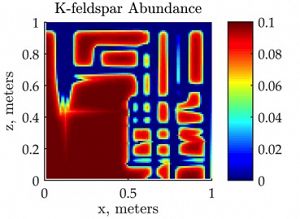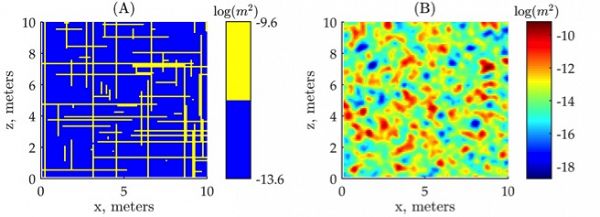Hydrology: Sachin Pandey Research Group
Spatial and temporal heterogeneity in subsurface water storage has been identified as a major knowledge-gap in Critical Zone science, despite its heavy influence on hydrochemistry and soil formation. For instance, we still lack a quantitative basis for characterizing the effect of dynamic fluid residence times, which are dictated by heterogeneity, on biogeochemical reactions, which drive weathering and solute fluxes in ground/surface waters. My research focuses on quantifying the extent of such heterogeneous fluid-rock interactions through the use of computational hydro-geochemical models.
Image: K-feldspar dissolution in a subsurface transect of the saprolite layer. The figure shows the mineral abundance profile after 100 kyr in a system initially containing a homogeneous distribution of K-feldspar (1/10th volume fraction) within a region were fracture flow paths induce preferential flow (vertical infiltration). Fractures are quickly depleted of reacting mineral (blue regions), and the system becomes diffusion-limited as reacting solutes must diffuse into regions of immobile water where reactive mineral remains (red regions). Vadose zone hydrology is coupled to mineral kinetics, aqueous geochemistry and microbial metabolism using the subsurface reactive transport code PFLOTRAN.
This group is tagged with:
Hydrology
Geomorphology
Biogeochemistry
Geology / Chronology
-
I am a recent Ph. D. graduate and have focused on the advanced scientific understanding of hydro-geochemistry in the Critical Zone through the use of state-of-the-art computational models. As a graduate student, I developed models of hydrology-driven mineral weathering phenomena in saprolite and bedrock within the Boulder Creek CZO, as well as models of acid rock drainage generation in mineralized watersheds. I enjoy collaborating with computational scientists to employ modern algorithms, along with field and laboratory experts to incorporate high quality datasets that help constrain model parameters. I have developed first-principles based numerical models that couple vadose zone hydrology, geochemistry, and microbiology over a wide range of spatio-temporal scales. Applications have included investigating the discrepancy between laboratory and field determined mineral weathering rates, the observed decrease of dissolution rates as minerals age over geologic timescales, and the influence of environmental uncertainties such as preferential flow (induced by subsurface heterogeneity) and climate change on hydrochemistry and solute effluxes.
Figure 1. Examples of heterogeneous permeability fields that have been developed using geostatistical methods to represent the subsurface of the Critical Zone. The first method, panel (A) shows a method that subdivides the domain into regions of low permeability saprolite and a high permeability, “discrete” fracture network. The second method, panel (B) shows a correlated random field generated using sequential Gaussian simulation, which is commonly used to represent heterogeneity in the subsurface but may not capture the sharp differences in permeability that would result from fracturing in a natural setting. Discrete fracture networks were found to result in a distinct hydrologic partitioning of water into mobile and immobile regions, which influenced both solute transport and weathering behavior in subsequent hydro-geochemical weathering simulations.
Figure 2. Sensitivity of weathering rates in a subsurface hydro-geochemical model of the Critical Zone to the different representations of heterogeneity shown in Figure 1. The model domain is an idealized subsurface transect of saprolite exposed to vertical infiltration of "fresh" water from the top boundary (z = 10 m) that reacts with minerals prior to leaving the system (z = 0 m). K-feldspar is uniformly distributed at 0 kyr, and the figure shows K-feldspar weathering rates after 300 kyr of simulation. (A) Shows dissolution rates in the discrete fracture network and (B) shows rates in the correlated random permeability field. There exists strong heterogeneity-dependence in the spatial distribution and magnitude of weathering for both cases. The permeability field of (A) may better represent natural fracturing since it results in a reaction zone distributed along fracture pathways and causes the development of reactive corestones. Evidence of these phenomena have been observed in Critical Zone observatories and other subsurface studies.
Figure 1. Examples of heterogeneous permeability fields that have been developed using geostatistical methods to represent the subsurface of the Critical Zone. The first method, panel (A) shows a method that subdivides the domain into regions of low permeability saprolite and a high permeability, “discrete” fracture network. The second method, panel (B) shows a correlated random field generated using sequential Gaussian simulation, which is commonly used to represent heterogeneity in the subsurface but may not capture the sharp differences in permeability that would result from fracturing in a natural setting. Discrete fracture networks were found to result in a distinct hydrologic partitioning of water into mobile and immobile regions, which influenced both solute transport and weathering behavior in subsequent hydro-geochemical weathering simulations.
Figure 2. Sensitivity of weathering rates in a subsurface hydro-geochemical model of the Critical Zone to the different representations of heterogeneity shown in Figure 1. The model domain is an idealized subsurface transect of saprolite exposed to vertical infiltration of "fresh" water from the top boundary (z = 10 m) that reacts with minerals prior to leaving the system (z = 0 m). K-feldspar is uniformly distributed at 0 kyr, and the figure shows K-feldspar weathering rates after 300 kyr of simulation. (A) Shows dissolution rates in the discrete fracture network and (B) shows rates in the correlated random permeability field. There exists strong heterogeneity-dependence in the spatial distribution and magnitude of weathering for both cases. The permeability field of (A) may better represent natural fracturing since it results in a reaction zone distributed along fracture pathways and causes the development of reactive corestones. Evidence of these phenomena have been observed in Critical Zone observatories and other subsurface studies.
-
Contacts
Alumni-Former
GRAD STUDENT
.(JavaScript must be enabled to view this email address)
Hydrology
Explore Further




